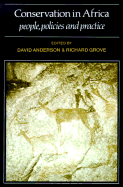Book contents
- Frontmatter
- Contents
- Preface
- List of contributors
- Introduction: The scramble for Eden: past, present and future in African conservation
- Part One Conservation ideologies in Africa
- Part Two Wildlife, Parks and Pastoralist
- Part Three Conservation priorities and rural communities
- Part Four Consequences for conservation and development
- Introduction
- 13 The political reality of conservation in Nigeria
- 14 Settlement, pastoralism and the commons: the ideology and practice of irrigation development in Northern Kenya
- 15 Approaches to water resource development, Sokoto Valley, Nigeria: the problem of sustainability
- 16 State policy and famine in the Awash Valley of Ethiopia: the lessons for conservation
- Index
15 - Approaches to water resource development, Sokoto Valley, Nigeria: the problem of sustainability
Published online by Cambridge University Press: 04 April 2011
- Frontmatter
- Contents
- Preface
- List of contributors
- Introduction: The scramble for Eden: past, present and future in African conservation
- Part One Conservation ideologies in Africa
- Part Two Wildlife, Parks and Pastoralist
- Part Three Conservation priorities and rural communities
- Part Four Consequences for conservation and development
- Introduction
- 13 The political reality of conservation in Nigeria
- 14 Settlement, pastoralism and the commons: the ideology and practice of irrigation development in Northern Kenya
- 15 Approaches to water resource development, Sokoto Valley, Nigeria: the problem of sustainability
- 16 State policy and famine in the Awash Valley of Ethiopia: the lessons for conservation
- Index
Summary
Introduction
In recent years there has been a growing awareness among development 'experts' (Chambers, 1983), of the importance of the natural environment, not simply as a constraint on possible action, but as part of the proper concern of development planning. In part this is the effect of the growth of environmentalism in the developed world in the 1970s (Sandbach, 1980; O'Riordan, 1981), in part a response to specific environment-related crises such as Sahelian drought and desertification. This interest has had two obvious results. First, there has been a realization that the welfare of the poorest groups in poor countries, themselves the target of recent development concerns such as the basic needs approach (e.g. Stewart, 1985), is closely related to environmental quality (Mabogunje, 1984). Second, there has been a search for a new paradigm of development based on knowledge about the limitations and potentials of the natural environment. This search has expanded from the definition of limits and criteria for development based on ecology (Dasmann, Milton & Freeman, 1973), to attempts to define an alternative to existing productivist paradigms of development in the form of ‘ecodevelopment’ (Riddell, 1981; Glaeser, 1984; cf. Redclift, 1984). Probably the best known statement of the principle that development can only be based on the conservation of the environment is the World Conservation Strategy (WCS), launched in 1979 by the International Union for the Conservation of Nature (IUCN, 1980).
- Type
- Chapter
- Information
- Conservation in AfricaPeoples, Policies and Practice, pp. 307 - 326Publisher: Cambridge University PressPrint publication year: 1988
- 3
- Cited by

